
 Congratulations! If you're snooping around in the fishing report archives, you must be one of the dedicated anglers who spends the extra time that it takes to become an expert at your craft!
Congratulations! If you're snooping around in the fishing report archives, you must be one of the dedicated anglers who spends the extra time that it takes to become an expert at your craft!
I respect folks who do their homework and that's why I have these reports archived. You can glean a lot of information about seasonal trends and movements of the fish in Northern Minnesota's Itasca Lakes Area. I've always believed that studying the fishing patterns and fish movements throughout the seasons would allow anglers to see the emergence of interesting trends that could help when forming a strategy for an upcoming fishing trip.
I know that you can find plenty of useful information, even in the earliest, silliest fishing reports written during my formative years. That's why I'm going through the entire website and dusting off all of the original fishing reports.
I hope that you will find a tidbit here and there that does you some good and I'd really appreciate hearing your comments and questions. Happy Fishing !! ![]() - Jeff Sundin 218-245-9858 or EMAIL
- Jeff Sundin 218-245-9858 or EMAIL
 Jeff Sundin Fishing Report Archives September 30, 2004
Jeff Sundin Fishing Report Archives September 30, 2004
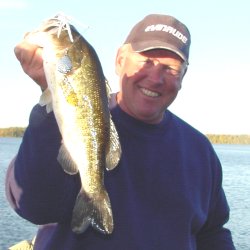 Largemouth Bass have been the highlight of my fishing week. Rod benders that hit hard have been the rule and without a doubt, early signs of the fall feeding frenzy are upon us.
Largemouth Bass have been the highlight of my fishing week. Rod benders that hit hard have been the rule and without a doubt, early signs of the fall feeding frenzy are upon us.
Usually by this time of year the fish locate on the outside edges of deeper weed patches that remain green after the die-off of shallow weeds. With water temperatures in the low sixty-degree range and warm sunny days, Bass are still somewhat scattered and located in the heavy green cover. Coontail patches in the midst of larger weed flats are producing some very nice Bass. Outside edges of mixed cabbage and Bulrushes are also showing signs of quality bass fishing.
No matter what kind of weed growth we’ve found, the presence of rocks in the immediate area has been a key to the most productive areas.
We haven’t found any of the large schools of fish that will be coming in the next couple of weeks, but there are some very nice small groups of fish showing up in these areas. I’m sure that there are a variety of baits that will produce, but we have been sticking with quality 3/8-ounce spinnerbaits. Particularly larger single Colorado blade models. These big thumpers are really getting the attention of the nicer 18 to 20 inch fish. White and Yellow have been top producers.
Bluegills have been slow to move out of their weed locations and as long as the weed flats continue to be green, the majority of these fish will remain in these areas. There are some fish out in open water with the schools of Crappies, but not enough to make it the top pattern just yet.
Most of the folks catching these fish right now are "stillfishing" with bobbers, small jigs and pieces of worm or small bluegill size leeches. Locate the better areas by slowly creeping through the weed flats with light jigs tipped with worms. Stop as soon as you locate a school of fish and either anchor the boat or hover with an electric trolling motor.
Northern Pike of small to medium size are mixed in the weeds along with most of the other fish. We’ve caught a ton of these one to four pound fish with jig & minnow combos. We’ve caught a few fish as large as 30 inches or so but these are the exception right now. The majority of the better size fish being caught in the shallows are being caught using large Sucker Minnows.
Some folks are getting action on decent fish by trolling with shallow running crankbaits. Salmo’s floating Whitefish series has been getting us a few nicer fish. Pike located in the deeper water are also being caught trolling deeper running crankbaits like Salmo’s Perch Series baits or by using large minnows on a live bait spinner rig. We’ve caught some nice fish trolling with in 18 to 22 feet of water, following the edges of the larger main lake bars. Use a heavy 17 to 25 pound test monofilament leader, a 4/0 hook and a number 2 or 3 Colorado spinner blade. Work the rig as you would a live bait rig for walleyes with the minnow lip hooked. When you feel a pick up, feed out line for a half minute or so and set the hook only when you’ve gathered all of your slack line back on the reel.
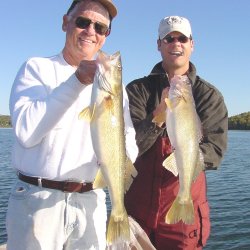 Walleyes remain on the sluggish, but catch-able list. We have located some schools of fish in almost every conceivable location.
Walleyes remain on the sluggish, but catch-able list. We have located some schools of fish in almost every conceivable location.
Some are deep, some are shallow and some are on the flats. This is the quintessential definition of the phrase "spotty fishing". The consensus among a variety of experts is that a combination of higher than normal water temperatures and amazingly high baitfish populations are holding the fish back from going into high gear. One thing that remains constant is that if you can locate these fish, there’s a very good chance that you can catch them. A pattern that has emerged this week is the "twilight bite" and we have been pretty successful at locating better schools of fish during the day and then heading to the most productive looking spots toward evening. This is paying off for me as the fish feed heavily for about an hour just before dark.
Some friends are catching fish using jig & minnow combinations, but we continue to fish with live bait rigs. Five to six foot leaders, a number 2 hook tipped with a larger Red Tail or Creek Chubb are producing some larger fish. The same rig tipped with lively night crawlers is producing more numbers of "eating size" fish.
Perch action has kicked up a notch and some folks are enjoying pretty fair fishing in terms of both numbers and size. Schools of fish are randomly scattered and most folks are finding them while in the search for Walleyes. Shallow weeds and mixed rock have been better areas and "simple, but effective", jig & minnow fishing is doing the trick.
Crappies are fully in to their fall open water mode and can be found in water from 18 to 30 feet deep. They are still relating loosely to the deep breaklines, but there are now also some small schools of fish roaming open water away from the structure. Best bet for success is to keep on the move and stop only when you locate better groups of fish. This will really swing the odds in you favor. The standard approach of using jig & minnow and fishing vertically is still working fine, but there are times when we’ve used a live bait rig tipped with a lively minnow as "search baits". We troll around slowly until we make contact with a better school of fish. Once we find a good school, we’ll switch back to the jigs for more precise control.
Smallmouth Bass remain grouped up on deep-water rock/gravel points and humps. They can still be caught on artificial baits with Tube Jigs and crank-baits leading the way. Live bait rigging with large lively minnows or Leeches will also produce some nice catches, but be careful not to allow the fish too much time to swallow live bait. In general, we release all Smallmouth and live bait fishing can put some of these fish at risk. So try the artificial baits first, then go to the live bait only as needed. ![]() - Jeff Sundin 218-245-9858 or EMAIL
- Jeff Sundin 218-245-9858 or EMAIL
 Jeff Sundin Fishing Report Archive September 23, 2004 "Walleye Scattered, But Feeding – Find ‘em and they are yours!"
Jeff Sundin Fishing Report Archive September 23, 2004 "Walleye Scattered, But Feeding – Find ‘em and they are yours!"
It’s been a pattern we’ve seen for the past few years now, Walleyes that are feeding heavily for the up coming winter, but are not yet gathered in large numbers. The good news is that when you find them, they will most likely bite at least for a pass or two. In fact, we’ve had some of those good old-fashioned rod-ripping bites this past week. The kind where you think there has to be a Northern on the end of your line and it turns out to be a Walleye instead.
The only problem is we’re just not getting the bites as often as we’d like. Sometimes it feels like we’re looking for a needle in a haystack because the fish are spread out over such a wide area, it makes it hard to recognize a pattern that you can stick with. The best advice I have at the moment is to cover plenty of water and don’t stop the search until you find enough fish to make a day of it. Last week we fished 10 lakes in 6 days and found almost the same situation everywhere. Scattered, but biting fish.
High winds have forced us to stick with the weed patterns most days and I’ve found that the best bet has been to first move into the weeds and then back out to the upper lip of the drop-off just where it begins to move deeper. We’ve had about equal success using jig & minnow or live bait rigs with Crawlers. There has been a few times where live bait rigs with large minnows have also brought in some fish. Stay on this upper edge and occasionally back out just enough to watch for fish on the upper portion of this break. Most of the time when I’ve gone all the way down the drop, lets say out to 22 feet or so, I’ve found mainly Northern Pike and Crappies.
Another pattern that’s worked for me has been to keep close watch of my electronics during the day and keep a mental note of areas where you mark the best numbers of fish. Come back to these areas a couple of times each day and especially just before sunset. If you can gear up for some trolling after dark, we’ve had some good results by moving up onto the shallow weed edges and trolling with Salmo’s Stings for about the last hour of daylight. There has usually been a nice burst of mixed Pike and Walleye action.
Perch action continues to be generally fair, with some decent groups of fish in the shallow weeds and some smaller groups of larger fish being found on deeper humps and bars. Even though a lot of the fish are smaller, we’ve continued to concentrate on the shallow weeds because there has been much more action. If you stick with it, fish of nine to eleven inches are available and in numbers enough to keep the action interesting. Our better fishing has been by pitching the jig into heavy weeds and hopping it back toward the boat. Once your jig is near the boat, fish vertically for a while to give the following fish a chance to strike.
Largemouth Bass are still mainly occupying the deeper weed edges and heavier weed patches up on the weed flats. Small plastic worms rigged Texas Style or on 1/8 ounce jig heads and fished slowly down the drop off edges will still produce some bass. It’s important to fish each spot more thoroughly because these fish are not moving very far out of cover to hit the bait. They can still be caught, but it may take several casts to the same fish before your bait gets close enough to entice a strike. Weed growth is still extremely good and green, so there hasn’t been much incentive for the bass to switch locations. Just keep it simple, go catch ‘em and have fun.
Smallmouth Bass remain grouped up on deep-water rock/gravel points and humps. They can still be caught on artificial baits with Tube Jigs and crank-baits leading the way. Live bait rigging with large lively minnows or Leeches will also produce some nice catches, but be careful not to allow the fish too much time to swallow live bait. In general, we release all Smallmouth and live bait fishing can put some of these fish at risk. So try the artificial baits first, then go to the live bait only as needed.
Crappies are fully in to their fall open water mode and can be found in water from 18 to 30 feet deep. They are still relating loosely to the deep breaklines, but there are now also some small schools of fish roaming open water away from the structure.
Best bet for success is to keep on the move and stop only when you locate better groups of fish. This will really swing the odds in you favor. The standard approach of using jig & minnow and fishing vertically is still working fine, but there are times when we’ve used a live bait rig tipped with a lively minnow as "search baits". We troll around slowly until we make contact with a better school of fish. Once we find a good school, we’ll switch back to the jigs for more precise control.
Bluegills are slowly moving away from heavy weed patches and starting to show up out in the open water with the Crappies. Numbers are not great just yet, but the stage is set for a strengthening bite as the water continues to cool. To check for the ‘gills, follow roughly the same pattern as for the Crappies. A smaller jig like an ice fly or 1/16 ounce jig head tipped with wax worms or cut night crawlers will be better for these fish. Add split shot sinkers as needed to get your bait to the bottom when moving.
Northern Pike of small to medium size are mixed in the weeds along with most of the other fish. We’ve caught a ton of these one to four pound fish with jig & minnow combos. We’ve caught a few fish as large as 30 inches or so but these are the exception right now. The majority of the better size fish being caught in the shallows are being caught using large Sucker Minnows.
Some folks are getting action on decent fish by trolling with shallow running crankbaits. Salmo’s floating Whitefish series has been getting us a few nicer fish. Pike located in the deeper water are also being caught trolling deeper running crankbaits like Salmo’s Perch Series baits or by using large minnows on a live bait spinner rig. We’ve caught some nice fish trolling with in 18 to 22 feet of water, following the edges of the larger main lake bars. Use a heavy 17 to 25 pound test monofilament leader, a 4/0 hook and a number 2 or 3 Colorado spinner blade. Work the rig as you would a live bait rig for walleyes with the minnow lip hooked. When you feel a pick up, feed out line for a half minute or so and set the hook only when you’ve gathered all of your slack line back on the reel. ![]() - Jeff Sundin 218-245-9858 or EMAIL
- Jeff Sundin 218-245-9858 or EMAIL
 Jeff Sundin Fishing Report Archive September 16, 2004 "Northern Minnesota Early Fall Fishing Progress Report"
Jeff Sundin Fishing Report Archive September 16, 2004 "Northern Minnesota Early Fall Fishing Progress Report"
 Update Notice: This is one of the rare times in Minnesota Fishing where the weather and fishing patterns have remained fairly consistent for the past week or so. For the most part, the fishing strategies and advice from last week’s report are probably best left unchanged for a few days. So except for the general overview, some minor additions and a bit of shuffling, the report has changed little.
Update Notice: This is one of the rare times in Minnesota Fishing where the weather and fishing patterns have remained fairly consistent for the past week or so. For the most part, the fishing strategies and advice from last week’s report are probably best left unchanged for a few days. So except for the general overview, some minor additions and a bit of shuffling, the report has changed little.
Southeast winds and sunny days have brought us another week of warm shirtsleeve temperatures. The most noticeable change on the lakes has been the influx of baitfish into the shallows. Huge schools minnows consisting mostly of young of the year Perch, can be found on the outside, inside and on top of nearly every weed bed on most of the lakes we’ve fished this week. With the abundance of food and warm sunny days, has come a fishing pattern that has a lot of folks pulling their hair out.
Fish are still being caught and occasionally in good numbers, but your timing will be really important and you’ll need to keep searching for spots that have active fish at the time you are there. We’ve marked several schools of fish and after catching the first few "BITERS", the rest of the school gets weary of the pressure from above and the bite is over. The best approach in a lot of these cases has been to make one pass or maybe two at the most and then move on to greener pastures. Finding new water that hasn’t been pressured seems to help quite a bit and I’d recommend staying out of the larger crowds except for those rare days where the fish are on more of a "peak bite". In other words, if you work at it, you’ll catch enough fish to keep you happy.
Walleyes are still found not only in the shallow weeds, but also on deeper main lake structures. Some anglers found the best action by fishing live bait rigs with Leeches and Night Crawlers on the breaklines at 16 to 24 feet. Smaller humps that are generally good in early/mid summer held a few fish too, but the larger bars with both immediate access into deep water and easy access to the shoreline flats were prime locations. We’re locating schools of fish that are moving from deeper water or large flats as they move toward the shoreline and vice versa. The huge flats associated with these structures have room for lots of fish to spread out while they roam around looking for easy feeding opportunities.
There are always a few "false starts" in the early fall where it begins to look like the shallow fall patterns have begun and then without warning, the fish move back out to the main lake. I believe this is the time of the season when the Walleye action comes and goes with the wind and fish that move in to the shallows at "prime feeding times" give us this false impression of a long lasting move to the shallows.
Playing the wind to your advantage is really fairly simple. When it gets windy, we concentrate on the shallow breaklines and the calmer days generally call for fishing the deeper structures or in the heaviest weeds. Wind speed and direction are equally important and I tend to favor areas where the wind is moving parallel or slightly into the shoreline. A key tip to remember is that fish will usually travel into the current that’s generated by the waves. So if the wind blows from the same direction for a sustained period, you should be expecting fish to move slowly ahead into the current and stop to feed as they encounter pockets of baitfish that gather behind points or in weed beds.
Right now, there are quite a few folks still using live bait rigs with Crawlers and Leeches in the shallow water, but we’re catching a wider variety of fish and enjoying a lot more fishing action by using jig & minnow combinations and occasionally jig & crawler combos. Depending on the lake, this jigging approach has allowed us to catch as many as six different species in the same trip, fishing the same water.
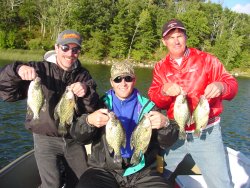 Largemouth Bass are still mainly occupying the deeper weed edges and heavier weed patches up on the weed flats. Small plastic worms rigged Texas Style or on 1/8 ounce jig heads and fished slowly down the drop off edges will still produce some bass. It’s important to fish each spot more thoroughly because these fish are not moving very far out of cover to hit the bait. They can still be caught, but it may take several casts to the same fish before your bait gets close enough to entice a strike. Weed growth is still extremely good and green, so there hasn’t been much incentive for the bass to switch locations. Just keep it simple, go catch ‘em and have fun.
Largemouth Bass are still mainly occupying the deeper weed edges and heavier weed patches up on the weed flats. Small plastic worms rigged Texas Style or on 1/8 ounce jig heads and fished slowly down the drop off edges will still produce some bass. It’s important to fish each spot more thoroughly because these fish are not moving very far out of cover to hit the bait. They can still be caught, but it may take several casts to the same fish before your bait gets close enough to entice a strike. Weed growth is still extremely good and green, so there hasn’t been much incentive for the bass to switch locations. Just keep it simple, go catch ‘em and have fun.
Crappies that had been really snapping in the open water on several area lakes the past couple of weeks have had an awful lot of pressure put on them and the bite can be hit or miss depending on the traffic on the lake you choose to fish. The Crappies have shown a preference for locating closer to "cover" this week, but there are still a lot of smaller schools in open water as well.
The best action has been concentrated on scattered brush piles or deeper weed beds. Bait choice is really simple, small jigs tipped with minnows are the standard. But we’ve had some nice action with the "safety pin style spinners" like a beetle spin or horse head type jig. Fishing the brush piles is a little tricky, but remember this simple tip to make your life a lot easier; when you feel your jig touch the brush, NEVER PULL! Always let it drop. Most of the time, you can get the jig to fall off of the branch and then you can wiggle it back up. This helps keep your bait in the strike zone and if you can remember this simple tip, you will catch many more Crappies than you ever did before.
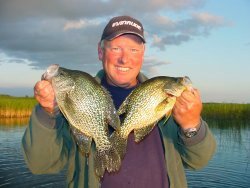 Bluegills are in the heavy weed patches feeding on what looks like some kind late summer bug hatch. The best approach for finding them has been to slowly creep along the deeper weed edges while casting a jig & half crawler combination into the weeds. As soon as you pick up a fish or two, stop the boat and switch to a small jig tipped with a piece or crawler or a smaller angleworm. Fish slowly, almost stationary within a few inches of the bottom and set the hook as soon as you feel the tiniest "tick" on your line. Darker jig colors have been good and 1/16 ounce has been the best size overall, but 1/8 ounce may be needed on breezy days.
Bluegills are in the heavy weed patches feeding on what looks like some kind late summer bug hatch. The best approach for finding them has been to slowly creep along the deeper weed edges while casting a jig & half crawler combination into the weeds. As soon as you pick up a fish or two, stop the boat and switch to a small jig tipped with a piece or crawler or a smaller angleworm. Fish slowly, almost stationary within a few inches of the bottom and set the hook as soon as you feel the tiniest "tick" on your line. Darker jig colors have been good and 1/16 ounce has been the best size overall, but 1/8 ounce may be needed on breezy days.
Smallmouth Bass remain grouped up on deep-water rock/gravel points and humps. They can still be caught on artificial baits with Tube Jigs and crank-baits leading the way. Live bait rigging with large lively minnows or Leeches will also produce some nice catches, but be careful not to allow the fish too much time to swallow live bait. In general, we release all Smallmouth and live bait fishing can put some of these fish at risk. So try the artificial baits first, then go to the live bait only as needed.
Perch action continues to be generally fair, with some decent groups of fish in the shallow weeds and some smaller groups of larger fish being found on deeper humps and bars. Even though a lot of the fish are smaller, we’ve continued to concentrate on the shallow weeds because there has been much more action. If you stick with it, fish of nine to eleven inches are available and in numbers enough to keep the action interesting. Our better fishing has been by pitching the jig into heavy weeds and hopping it back toward the boat. Once your jig is near the boat, fish vertically for a while to give the following fish a chance to strike.
Northern Pike of small to medium size are mixed in the weeds along with most of the other fish. We’ve caught a ton of these one to four pound fish with jig & minnow combos. We’ve caught a few fish as large as 30 inches or so but these are the exception right now. The majority of the better size fish being caught in the shallows are being caught using large Sucker Minnows.
Some folks are getting action on decent fish by trolling with shallow running crankbaits. Salmo’s floating Whitefish series has been getting us a few nicer fish. Pike located in the deeper water are also being caught trolling deeper running crankbaits like Salmo’s Perch Series baits or by using large minnows on a live bait spinner rig. We’ve caught some nice fish trolling with in 18 to 22 feet of water, following the edges of the larger main lake bars. Use a heavy 17 to 25 pound test monofilament leader, a 4/0 hook and a number 2 or 3 Colorado spinner blade. Work the rig as you would a live bait rig for walleyes with the minnow lip hooked. When you feel a pick up, feed out line for a half minute or so and set the hook only when you’ve gathered all of your slack line back on the reel. ![]() - Jeff Sundin 218-245-9858 or EMAIL
- Jeff Sundin 218-245-9858 or EMAIL
 Jeff Sundin Fishing Report Archive September 6, 2004 "Early Fall Fishing Report"
Jeff Sundin Fishing Report Archive September 6, 2004 "Early Fall Fishing Report"
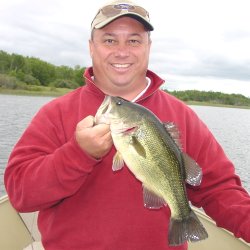 After a couple of weeks of below normal temperatures, it had begun to look like the typical fall fishing patterns were here to stay, but a re-birth of summer brought us air temperatures in the high seventies to low eighties and water temps back up into the mid sixties. Along with the warmer temperatures, came a re-birth of late summer style fishing for Walleye, Bass and Panfish.Walleyes were found not only in the shallow weeds, but also on deeper main lake structures again. Some anglers found the best action by fishing live bait rigs with Leeches and Night Crawlers on the breaklines at 16 to 24 feet. Smaller humps that are generally good in early/mid summer held a few fish too, but the larger bars with both immediate access into deep water and easy access to the shoreline flats were prime locations. We’re locating schools of fish that are moving from deeper water or large flats as they move toward the shoreline and vice versa. The huge flats associated with these structures have room for lots of fish to spread out while they roam around looking for easy feeding opportunities.
After a couple of weeks of below normal temperatures, it had begun to look like the typical fall fishing patterns were here to stay, but a re-birth of summer brought us air temperatures in the high seventies to low eighties and water temps back up into the mid sixties. Along with the warmer temperatures, came a re-birth of late summer style fishing for Walleye, Bass and Panfish.Walleyes were found not only in the shallow weeds, but also on deeper main lake structures again. Some anglers found the best action by fishing live bait rigs with Leeches and Night Crawlers on the breaklines at 16 to 24 feet. Smaller humps that are generally good in early/mid summer held a few fish too, but the larger bars with both immediate access into deep water and easy access to the shoreline flats were prime locations. We’re locating schools of fish that are moving from deeper water or large flats as they move toward the shoreline and vice versa. The huge flats associated with these structures have room for lots of fish to spread out while they roam around looking for easy feeding opportunities.
There are always a few "false starts" in the early fall where it begins to look like the shallow fall patterns have begun and then without warning, the fish move back out to the main lake. I believe this is the time of the season when the Walleye action comes and goes with the wind and fish that move in to the shallows at "prime feeding times" give us this false impression of a long lasting move to the shallows.
Playing the wind to your advantage is really fairly simple. When it gets windy, we concentrate on the shallow breaklines and the calmer days generally call for fishing the deeper structures or in the heaviest weeds. Wind speed and direction are equally important and I tend to favor areas where the wind is moving parallel or slightly into the shoreline. A key tip to remember is that fish will usually travel into the current that’s generated by the waves. So if the wind blows from the same direction for a sustained period, you should be expecting fish to move slowly ahead into the current and stop to feed as they encounter pockets of baitfish that gather behind points or in weed beds.
Right now, there are quite a few folks still using live bait rigs with Crawlers and Leeches in the shallow water, but we’re catching a wider variety of fish and enjoying a lot more fishing action by using jig & minnow combinations and occasionally jig & crawler combos. Depending on the lake, this jigging approach has allowed us to catch as many as six different species in the same trip, fishing the same water.
Largemouth Bass are still mainly occupying the deeper weed edges and heavier weed patches up on the weed flats. Small plastic worms rigged Texas Style or on 1/8 ounce jig heads and fished slowly down the drop off edges will still produce some bass. It’s important to fish each spot more thoroughly because these fish are not moving very far out of cover to hit the bait. They can still be caught, but it may take several casts to the same fish before your bait gets close enough to entice a strike. Weed growth is still extremely good and green, so there hasn’t been much incentive for the bass to switch locations. Just keep it simple, go catch ‘em and have fun.
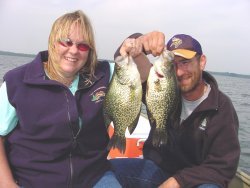 Crappies that had been really snapping in the open water on several area lakes the past couple of weeks have shown a preference for locating closer to "cover" this week. The action has been just as good or perhaps even better, but we’ve had to concentrate on brush piles or deeper weed beds if we wanted to get in on the hot bite. Bait choice is really simple, small jigs tipped with minnows are the standard. But we’ve had some nice action with the "safety pin style spinners" like a beetle spin or horse head type jig. Fishing the brush piles is a little tricky, but remember this simple tip to make your life a lot easier; when you feel your jig touch the brush, NEVER PULL! Always let it drop. Most of the time, you can get the jig to fall off of the branch and then you can wiggle it back up. This helps keep your bait in the strike zone and if you can remember this simple tip, you will catch many more Crappies than you ever did before.
Crappies that had been really snapping in the open water on several area lakes the past couple of weeks have shown a preference for locating closer to "cover" this week. The action has been just as good or perhaps even better, but we’ve had to concentrate on brush piles or deeper weed beds if we wanted to get in on the hot bite. Bait choice is really simple, small jigs tipped with minnows are the standard. But we’ve had some nice action with the "safety pin style spinners" like a beetle spin or horse head type jig. Fishing the brush piles is a little tricky, but remember this simple tip to make your life a lot easier; when you feel your jig touch the brush, NEVER PULL! Always let it drop. Most of the time, you can get the jig to fall off of the branch and then you can wiggle it back up. This helps keep your bait in the strike zone and if you can remember this simple tip, you will catch many more Crappies than you ever did before.
Bluegills are in the heavy weed patches feeding on what looks like some kind late summer bug hatch. The best approach for finding them has been to slowly creep along the deeper weed edges while casting a jig & half crawler combination into the weeds. As soon as you pick up a fish or two, stop the boat and switch to a small jig tipped with a piece or crawler or a smaller angleworm. Fish slowly, almost stationary within a few inches of the bottom and set the hook as soon as you feel the tiniest "tick" on your line. Darker jig colors have been good and 1/16 ounce has been the best size overall, but 1/8 ounce may be needed on breezy days.
Smallmouth Bass remain grouped up on deep-water rock/gravel points and humps. They can still be caught on artificial baits with Tube Jigs and crank-baits leading the way. Live bait rigging with large lively minnows or Leeches will also produce some nice catches, but be careful not to allow the fish too much time to swallow live bait. In general, we release all Smallmouth and live bait fishing can put some of these fish at risk. So try the artificial baits first, then go to the live bait only as needed.
Perch action continues to be generally fair, with some decent groups of fish in the shallow weeds and some smaller groups of larger fish being found on deeper humps and bars. Even though a lot of the fish are smaller, we’ve continued to concentrate on the shallow weeds because there has been much more action. If you stick with it, fish of nine to eleven inches are available and in numbers enough to keep the action interesting. Our better fishing has been by pitching the jig into heavy weeds and hopping it back toward the boat. Once your jig is near the boat, fish vertically for a while to give the following fish a chance to strike.
Northern Pike of small to medium size are mixed in the weeds along with most of the other fish. We’ve caught a ton of these one to four pound fish with jig & minnow combos. We’ve caught a few fish as large as 30 inches or so but these are the exception right now. The majority of the better size fish being caught in the shallows are being caught using large, Musky style baits like the Suick, Reef Hawg and Giant RattleTraps. Pike located in the deeper water are being caught trolling crankbaits like Salmo’s Perch Series baits or by using large minnows on a live bait spinner rig. We’ve caught some nice fish trolling with in 18 to 22 feet of water, following the edges of the larger main lake bars. ![]() - Jeff Sundin 218-245-9858 or EMAIL
- Jeff Sundin 218-245-9858 or EMAIL
 Jeff Sundin Fishing Report Archive August 26, 2004 "Hints of Fall, Crappies Capture the Lead in Action Fishing"
Jeff Sundin Fishing Report Archive August 26, 2004 "Hints of Fall, Crappies Capture the Lead in Action Fishing"
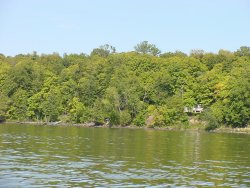 Many areas of the 1000 Grand Lakes Region were treated to the first killing frost of the season last week. The trees are showing some early fall color, some of the shallow weed growth is beginning to thin and water temperatures have cooled down to the low 60’s.
Many areas of the 1000 Grand Lakes Region were treated to the first killing frost of the season last week. The trees are showing some early fall color, some of the shallow weed growth is beginning to thin and water temperatures have cooled down to the low 60’s.
Crappies have shown us the first glimpse of the fall fishing to come. On several area lakes, these fish suspending in fairly large groups over open water, sometimes near shoreline weeds or deeper main lake structures like meandering bars and softer bottom humps. On several other lakes they are still using the weeds and can be found in areas of mixed Cabbage and Coontail adjacent to deeper water. Key depths have been from 12 to 24 feet depending on the type of structure they’re using. Although these fish are beginning to group up, they have not formed the huge schools that we will begin to see in a couple of weeks.
Searching the structures with your electronics, try to locate the larger schools of fish and work vertically over the top of these Crappies with jig/minnow combinations. Some of the schools are feeding aggressively while others aren’t. So it really pays to be persistent. Don’t give up until you’ve tried several schools of fish. If you haven’t been able to locate larger schools of fish, follow the deeper drop-off edges and fish slowly with a live bait rig using a five-foot leader and tip the hook with a small, lively minnow. As you move along, you’ll pick up some of the small groups of fish. When you locate a groups that shows some potential, stop the boat and try the vertical approach for a few minutes and repeat the process as needed.
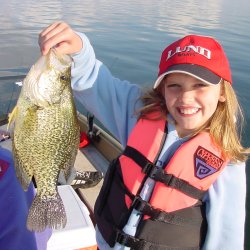 Largemouth Bass are now mainly occupying the deeper weed edges and heavier weed patches up on the weed flats. Small plastic worms rigged Texas Style or on 3/16 ounce jig heads and fished slowly down the drop off edges will still produce some bass. It’s important to fish each spot more thoroughly because these fish are not moving very far out of cover to hit the bait. They can still be caught, but it may take several casts to the same fish before your bait gets close enough to entice a strike.Walleyes are on the move, following the minnows and it’s frustrating to have to try and locate a new school of fish every day. Thanks to the cool weather, many of the lakes have unusually clear water right now and the fish are using the heavier shallow weeds for cover. On windy days, these fish have provided enough action to keep us interested. Keep the boat in or near the best weed patches and use a Jig & Minnow for the most action. We’ve still had some success with Crawlers, but it’s been a slower process and working in heavy weeds with "yard bait" can be frustrating. On clam days, these fish are spreading out on mid depth flats and we’ve had mixed results fishing with Crank Baits and Spinners. It’s easy enough to spot fish on the electronics, but some of these fish just won’t bite (perhaps during daylight hours they are holding on the flats, waiting to make an evening run). Occasionally we can get one of these small groups of fish interested and when we do, it’s been best to switch from trolling back to a jig & minnow and stay with the school as long as possible. When it breaks up or gets spooky, we go back on the prowl.
Largemouth Bass are now mainly occupying the deeper weed edges and heavier weed patches up on the weed flats. Small plastic worms rigged Texas Style or on 3/16 ounce jig heads and fished slowly down the drop off edges will still produce some bass. It’s important to fish each spot more thoroughly because these fish are not moving very far out of cover to hit the bait. They can still be caught, but it may take several casts to the same fish before your bait gets close enough to entice a strike.Walleyes are on the move, following the minnows and it’s frustrating to have to try and locate a new school of fish every day. Thanks to the cool weather, many of the lakes have unusually clear water right now and the fish are using the heavier shallow weeds for cover. On windy days, these fish have provided enough action to keep us interested. Keep the boat in or near the best weed patches and use a Jig & Minnow for the most action. We’ve still had some success with Crawlers, but it’s been a slower process and working in heavy weeds with "yard bait" can be frustrating. On clam days, these fish are spreading out on mid depth flats and we’ve had mixed results fishing with Crank Baits and Spinners. It’s easy enough to spot fish on the electronics, but some of these fish just won’t bite (perhaps during daylight hours they are holding on the flats, waiting to make an evening run). Occasionally we can get one of these small groups of fish interested and when we do, it’s been best to switch from trolling back to a jig & minnow and stay with the school as long as possible. When it breaks up or gets spooky, we go back on the prowl.
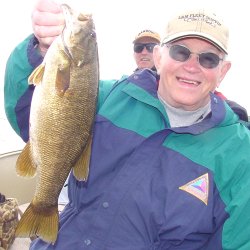 Smallmouth Bass like this one caught by Barney Johnson on a jig & minnow are using the steep points adjacent to larger flats. Sneak up on these areas to avoid "spooking the school" before you get a chance to cast to them. As always, we recommend releasing these beautiful fish to help ensure good fishing in the future.
Smallmouth Bass like this one caught by Barney Johnson on a jig & minnow are using the steep points adjacent to larger flats. Sneak up on these areas to avoid "spooking the school" before you get a chance to cast to them. As always, we recommend releasing these beautiful fish to help ensure good fishing in the future.
Smallmouth Bass remain grouped up on deep-water rock/gravel points and humps. They can still be caught on artificial baits with Tube Jigs and crank-baits leading the way. Jig and Minnow or Live bait rigging with large lively minnows or Leeches is necessary at times when the fish are too spooky for artificial baits and will also produce some nice catches, but be careful not to allow the fish too much time to swallow live bait. In general, we release all Smallmouth and live bait fishing can put some of these fish at risk. So try the artificial baits first, then go to the live bait only as needed.
Northern Pike have also moved out on to these flats and many of the areas we find Walleyes are also holding small to medium size Pike. To key in on more Northern Pike, troll your crank baits in areas with good stretches of mixed rock and gravel. Watch for some of the steeper drop-offs and do your best to hug these edges.
Perch action that was fairly good last week, has become sluggish again with many of the "weed fish" getting smaller and less numerous. The better fish we’ve caught have been in deeper water and are somewhat scattered on the flats. Hopefully, I’ll have better news next week. ![]() - Jeff Sundin 218-245-9858 or EMAIL
- Jeff Sundin 218-245-9858 or EMAIL
 Jeff Sundin Fishing Report Archive August 19, 2004 "Late Summer Weather Changes Force a Change in Fishing Tactics"
Jeff Sundin Fishing Report Archive August 19, 2004 "Late Summer Weather Changes Force a Change in Fishing Tactics"
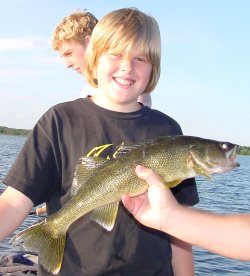 Here we go again! We had just about fully recovered from the passage of the last cold front and here comes another front gushing in from the Arctic Circle. On Wednesday we had enough wind to make almost everyone run for cover by mid day and I can honestly say that this was one of the few times I’ve ever seen the wind so strong that it made even the smaller lakes "un-fishable".
Here we go again! We had just about fully recovered from the passage of the last cold front and here comes another front gushing in from the Arctic Circle. On Wednesday we had enough wind to make almost everyone run for cover by mid day and I can honestly say that this was one of the few times I’ve ever seen the wind so strong that it made even the smaller lakes "un-fishable".
After the last front blew through just over a week ago, we found that the Northern Pike and Perch action had picked up a bit. Then as the weather stabilized and temperatures warmed, the Walleye fishing gradually recovered as well. I’d expect the recovery to come somewhat more rapidly this time, because the water temps had already taken the big plunge from the last front and because the storms that blew in ahead of this front were nowhere near the severity of the last ones. In another couple of weeks the fall patterns will begin to emerge and we’ll be looking forward to these cooler temperatures.
Here’s the pattern I’d be watching for in the next few days. By this past Sunday, Walleyes were following the minnows and it was common to find the fish moving freely and remaining in one spot only so long as the minnows were still in that area. Even though the majority of this movement had been in shallow water with weed cover, there were still small groups of fish using main lake structures like humps and small bars. We had been consistently catching fish on jigs and minnows until the warm weather took hold on Tuesday.
The speed of presenting the baits became more important and Spinners tipped with crawlers or minnows, as well as crankbaits became a better approach. In fact, Tuesday was one of the better Walleye trips this month and we caught almost all of the fish on crankbaits. Trolling the shallow weed line from 8 to 10 feet of water (depending on the weeds), with either Salmo’s "Sting series" or the old stand by Shad Rap was the clear ticket. You need baits that run just barely over the top of the deeper weeds, so don’t get too worried about hitting the bottom of the lake. These more active fish will come up for the bait.
The same approach has worked out on the deeper flats except you’ll need baits that get down to 16 to 20 feet. Salmo’s "Perch Series" has been the ticket for these areas. Whenever we’ve contacted fish that won’t take the crankbaits, we always make a pass or two using rigs or jigs and we’ve picked up plenty of fish. The one thing that has been consistent is that the fish will move. You’ll have to be prepared to go find another group every couple of hours.
Smallmouth Bass remain grouped up on deep-water rock/gravel points and humps. They can still be caught on artificial baits with Tube Jigs and crank-baits leading the way. Live bait rigging with large lively minnows or Leeches will also produce some nice catches, but be careful not to allow the fish too much time to swallow live bait. In general, we release all Smallmouth and live bait fishing can put some of these fish at risk. So try the artificial baits first, then go to the live bait only as needed.
Crappies are showing signs of moving to their fall patterns and are occasionally suspending in fairly large groups over open water, sometimes near shoreline weeds or deeper main lake structures like meandering bars and softer bottom humps. Searching the structures with your electronics, locate the larger schools of fish and work vertically over the top of the school with jig/minnow combinations. Some of the schools are feeding aggressively while others aren’t.
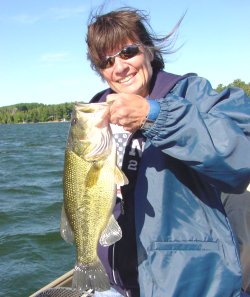 So it really pays to be persistent. Don’t give up until you’ve tried several schools of fish. Perch action has really picked up, with the best action in heavy to moderate weed cover. It’s even better if you can locate weed patches adjacent to gravel or light rock. Our best approach has been to fish along the weed edges pitching a jig and minnow into the heavier weeds. Once we locate an area that has some potential, we slow the boat down to a crawl and try to fish vertically over the school of fish. Whenever the action slows down, start fan casting around the area. This helps draw more fish closer to the boat. When the action slows down, repeat the process until you find the next batch of fish.
So it really pays to be persistent. Don’t give up until you’ve tried several schools of fish. Perch action has really picked up, with the best action in heavy to moderate weed cover. It’s even better if you can locate weed patches adjacent to gravel or light rock. Our best approach has been to fish along the weed edges pitching a jig and minnow into the heavier weeds. Once we locate an area that has some potential, we slow the boat down to a crawl and try to fish vertically over the school of fish. Whenever the action slows down, start fan casting around the area. This helps draw more fish closer to the boat. When the action slows down, repeat the process until you find the next batch of fish.
Last week was a Musky bonanza in the area and I know of at least 20 fish that were caught. Most of the fish have been coming on top water baits fished over weed/sand breaks. Try one of the tail spinning surface baits like a Turbo Jack or Dinner Bell and hold on tight.
Northern Pike have been plentiful, but not too large in the shallow weed areas. We’ve caught them on crankbaits while Walleye fishing as well as on jig/minnow combinations and even some fair size fish on jerk baits while we were Musky fishing. The better size fish still seem to be out on the flats and breaklines into deeper main lake areas. Tolling crankbaits or fishing with large Sucker Minnows on giant spinner rigs has been the ticket for dragging some of these fish out of the deep water. Concentrate on the deeper main lake flats with crankbaits that can run 16 to 20 feet deep and cover a lot of water. Take note of any special features like rocks or points that seem to be holding fish and then search for other similar structure.
Largemouth Bass are now mainly occupying the deeper weed edges and heavier weed patches up on the weed flats. Small plastic worms rigged Texas Style or on 3/16 ounce jig heads and fished slowly down the drop off edges will still produce some bass. It’s important to fish each spot more thoroughly because these fish are not moving very far out of cover to hit the bait. They can still be caught, but it may take several casts to the same fish before your bait gets close enough to entice a strike. ![]() - Jeff Sundin 218-245-9858 or EMAIL
- Jeff Sundin 218-245-9858 or EMAIL
 Jeff Sundin Fishing Report Archive 8-13-04 "Cold Front Blows Out Walleyes; Blows in Northern Pike and Perch"
Jeff Sundin Fishing Report Archive 8-13-04 "Cold Front Blows Out Walleyes; Blows in Northern Pike and Perch"
_reduced.jpg) Thanks to what is one of the most dramatic Mid Summer Cold Fronts I can remember, some types of fishing have been set back this week. Water temperatures have dropped from the low seventies down into the mid sixties in the past few days. While we are still managing to catch some fish, the action has dropped off for walleye, Musky and Bass. Interestingly, the Northern Pike and Perch action has actually improved and some of these fish have been better size than we were catching before the front.
Thanks to what is one of the most dramatic Mid Summer Cold Fronts I can remember, some types of fishing have been set back this week. Water temperatures have dropped from the low seventies down into the mid sixties in the past few days. While we are still managing to catch some fish, the action has dropped off for walleye, Musky and Bass. Interestingly, the Northern Pike and Perch action has actually improved and some of these fish have been better size than we were catching before the front.
Northern Pike have really perked up during the past week and even though we’re not seeing any really large Pike, we have been catching lots of the good "eating size" fish in the 2 to 4 pound range. We’ve been catching the better fish by casting Jerk baits like the Suick and shallow running crank baits like Salmo’s 7 inch Whitefish. A slow, deliberate retrieve giving the fish plenty of time to zero in on the bait has worked best. Another option for catching Pike is to drift across weed flats while fishing with Sucker Minnows and bobbers. This slower approach gives some of the more finicky fish a chance to locate and bite the bait and when you set up a good drifting pattern, there can be several people casting, while someone else is bobber fishing. Now you can cover both bases at once and there’s usually enough action to keep everyone interested.
Walleye fishing has moved in large part to the shallow weeds and we’ve been forced to get in and grind out enough fish to make a respectable catch. There are still nice fish being caught if you’re willing to work a bit more intensely on the project. Jigs tipped with minnows or live bait rigs tipped with leeches and crawlers are working equally well. Make sure you use a light enough bullet sinker or small egg sinker to allow you to wiggle the rig through the weeds. At times you’ll encounter groups of Perch or other panfish and I’d recommend slowing down and fishing the area thoroughly for them before moving on.
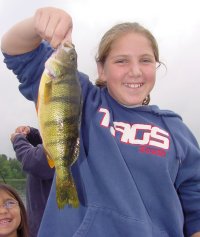 Perch action has really picked up, with the best action in heavy to moderate weed cover. It’s even better if you can locate weed patches adjacent to gravel or light rock. Our best approach has been to fish along the weed edges pitching a jig and minnow into the heavier weeds. Once we locate an area that has some potential, we slow the boat down to a crawl and try to fish vertically over the school of fish. Whenever the action slows down, start fan casting around the area. This helps draw more fish closer to the boat. When the action slows down, repeat the process until you find the next batch of fish.
Perch action has really picked up, with the best action in heavy to moderate weed cover. It’s even better if you can locate weed patches adjacent to gravel or light rock. Our best approach has been to fish along the weed edges pitching a jig and minnow into the heavier weeds. Once we locate an area that has some potential, we slow the boat down to a crawl and try to fish vertically over the school of fish. Whenever the action slows down, start fan casting around the area. This helps draw more fish closer to the boat. When the action slows down, repeat the process until you find the next batch of fish.
Largemouth Bass are now mainly occupying the deeper weed edges and heavier weed patches up on the weed flats. Small plastic worms rigged Texas Style or on 3/16 ounce jig heads and fished slowly down the drop off edges will still produce some bass. It’s important to fish each spot more thoroughly because these fish are not moving very far out of cover to hit the bait. They can still be caught, but it may take several casts to the same fish before your bait gets close enough to entice a strike.
Smallmouth Bass remain grouped up on deep-water rock/gravel points and humps. They can still be caught on artificial baits with Tube Jigs and crank-baits leading the way. Live bait rigging with large lively minnows or Leeches will also produce some nice catches, but be careful not to allow the fish too much time to swallow live bait. In general, we release all Smallmouth and live bait fishing can put some of these fish at risk. So try the artificial baits first, then go to the live bait only as needed.
Crappies are starting to show early signs of their fall patterns and are occasionally suspending in fairly large groups in open water, near shoreline weeds or main lake rock structure. The fish have been finicky and we’ve located several schools of fish that won’t bite the first time we see them. If we wait and return later in the afternoon or early evening, we can sometimes get them going. Vertical jigging with 1/8 or 1/16 ounce jigs above the school seems still to be the best approach, but we’ve had moderate success by rigging slip bobbers and casting to the school, rather than sitting on top of them. ![]() - Jeff Sundin 218-245-9858 or EMAIL
- Jeff Sundin 218-245-9858 or EMAIL
 Jeff Sundin Fishing Report Archive August 5, 2004 "Walleyes on the Flats Makes an Interesting Chase!"
Jeff Sundin Fishing Report Archive August 5, 2004 "Walleyes on the Flats Makes an Interesting Chase!"
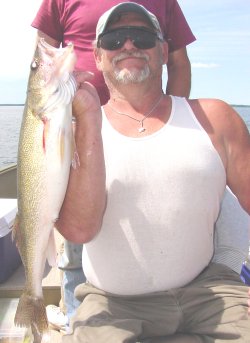 Walleye Fishing always has its twists & turns and this week has been no exception. One day we have great fishing on the main lake bars or humps in deep water, the next day we catch a good bunch in the weeds. But the most interesting twist has been their irksome habit of spreading out on main lake flats that meander for miles. It’s like taking a handful of marbles and flinging them across a gym floor. You know that all of the marbles are there, but you have to hunt them down one by one.
Walleye Fishing always has its twists & turns and this week has been no exception. One day we have great fishing on the main lake bars or humps in deep water, the next day we catch a good bunch in the weeds. But the most interesting twist has been their irksome habit of spreading out on main lake flats that meander for miles. It’s like taking a handful of marbles and flinging them across a gym floor. You know that all of the marbles are there, but you have to hunt them down one by one.
On some of those days when the fish just seem to disappear, we generally assume that they have suspended in deep water. But in many cases, these fish are active and feeding up on the top of these large flat areas. Lately, we’ve had some very successful afternoons by moving across these flats in 18 to 22 feet of water trolling with deep diving crank baits. Salmo’s Perch series has been one of the better baits for us because they run so true, we hardly ever have to "tune them up" and they run well at a fast speed, around 3.3 miles per hour.
Using this system, we pick up some fish with the crank baits and as we move along, I watch my graph for signs of larger schools of fish. When I think I’ve spotted a larger school, we stop and fish the area with the traditional Walleye baits like a plain live bait rig tipped with crawlers or leeches. More than a few times, these larger groups of fish have been using areas with patchy gravel and mixed rock. The spots are noticeable on your graph because the bottom reading changes, but they’re generally not associated with a significant change in water depth. We fish the area until the group of fish seems to have dissipated or moved, then go back to the trolling until we locate another group of fish.
This is a new system for a lot of folks and it’s really worth a try because you will learn a lot about the structure and about the movements of these fish. I can remember many days in the past when we’ve had slow fishing on the traditional spots and made the mistake of believing that they weren’t biting. On many of these days, the fish were up on the flats biting like crazy. We just didn’t think of going up there and hunting ‘em down.
Northern Pike are a bonus side benefit of this trolling pattern because they also use these large flats and are commonly caught while trolling with the crankbaits. There are some differences in the preferred colors, so if you experiment with colors, you’ll find some that trigger more Pike than Walleye.
Largemouth Bass are now mainly occupying the deeper weed edges and heavier weed patches up on the weed flats. We’ve still been able to catch some fish on spinnerbaits, but fishing the outside edges with plastic worms, has produced a lot more fish. Twelve to twenty feet of water, mixed Cabbage and Coontail and a good drop into deep water have been key areas for us.
Smallmouth Bass remain grouped up on deep-water rock/gravel points and humps. They can still be caught on artificial baits with Tube Jigs and crank-baits leading the way. Live bait rigging with large lively minnows or Leeches will also produce some nice catches, but be careful not to allow the fish too much time to swallow live bait. In general, we release all Smallmouth and live bait fishing can put some of these fish at risk. So try the artificial baits first, then go to the live bait only as needed.
Bluegills have begun showing up in the mid depth weeds and are being caught primarily in the evening using small jigs or plain hooks tipped with a simple cut piece of night crawler. Poke along the weeds slowly and fish until you make contact, then concentrate on that area until you’re convinced there’s a good school of fish. If the action tapers off, move on to a new location.
Perch action continues to improve with most of the fish coming from mid depth gravel bars that are home to small Crawfish or deeper water humps that harbor schools of young (3/4 inch) Perch minnows. Jig and minnow will catch some of these fish, but spinners or even a plain live bait rig tipped with a minnow will do nicely too. We’ve had some really nice fish, although I’d say numbers are down a bit compared to a normal summer. This means the best is probably still to come.
Crappies are starting to show early signs of their fall patterns and are occasionally suspending in fairly large groups in open water, near shoreline weeds or main lake rock structure. The fish have been finicky and we’ve located several schools of fish that won’t bite the first time we see them. If we wait and return later in the afternoon or early evening, we can sometimes get them going. Vertical jigging with 1/8 or 1/16 ounce jigs above the school seems still to be the best approach, but we’ve had moderate success by rigging slip bobbers and casting to the school, rather than sitting on top of them.
Muskies are still on the prowl and even though I haven’t continued to fish them this week, friends are reporting several sightings each day. Some of our better moon phases are still approaching, so I’m looking forward to some good Musky experiences in the next 10 to 20 days. Surface baits have out produced the others recently, but fish are still coming in to buck-tails and jerk baits as well. ![]() - Jeff Sundin 218-245-9858 or EMAIL
- Jeff Sundin 218-245-9858 or EMAIL
 Jeff Sundin Fishing Report Archive 8-2-04 "Finally! Muskellunge Action Picks up and Sightings Become Hook-Ups"
Jeff Sundin Fishing Report Archive 8-2-04 "Finally! Muskellunge Action Picks up and Sightings Become Hook-Ups"
_reduced.jpg) After a solid week of looking at vacant weed beds and waiting patiently for the occasional Musky sighting, The full Moon and weather finally converged to activate some of these fish. During the past several days, Musky activity in the shallow weeds has steadily picked up and now we're seeing many more fish, including some hook ups and some nice catches.
After a solid week of looking at vacant weed beds and waiting patiently for the occasional Musky sighting, The full Moon and weather finally converged to activate some of these fish. During the past several days, Musky activity in the shallow weeds has steadily picked up and now we're seeing many more fish, including some hook ups and some nice catches.
Best baits for us have been top water tail spinners like the Wades Hoggler that caught both of these fish. We also had some hook-ups on Suicks and the trusty Black Bucktail. Sand breaks with sparse to moderate weed edges have held enough fish to make life exciting.
Steve (Dr. Freud) Slaughter with Musky caught and released on the same day Jeff Sundin caught one earlier using top water baits over sparse weed beds. These fish had been sighted several times before finally hitting the big pay-off.
After a week of sluggish fishing for Northern Pike and Muskies, the approaching full moon, together with the rainy weather that moved in on Wednesday, teamed up to produce some above average action. We’ve been casting and trolling on Leech Lake, Moose Lake, Cutfoot Sioux, Winnie and Cass Lake for the past week and only seen a few fish, but yesterday we had five Muskies working our baits and caught a ton of small to medium sized Pike to boot. Some of these well-known areas were empty of fish as recently as this past Monday, so their sudden arrival was welcome to say the least. While we had some action on bucktails and tandem spinnerbaits, our best lure was the Suick fished at a slow-steady pace.
Black & Orange combos were best, with plain Black and Blue also producing some decent fish. If this plays out like past experiences, the action spurt will last until this weekend when the moon begins waning or until the weather gets sunny again whichever comes first. If the weather is predicted to be sunny, I’d recommend starting really early in the morning (before daylight if possible). Even on the worst days, there has been some movement in early morning or late evening.
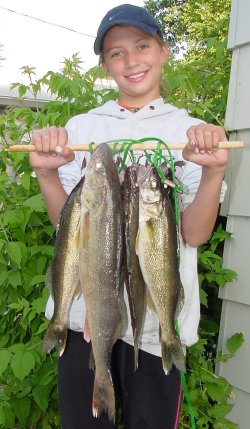 Bluegills and Crappies have begun showing up in the mid depth weeds and are being caught primarily in the evening using small jigs or plain hooks tipped with a simple cut piece of night crawler. Poke along the weeds slowly and fish until you make contact, then concentrate on that area until you’re convinced there’s a good school of fish. If the action tapers off, move on to a new location.
Bluegills and Crappies have begun showing up in the mid depth weeds and are being caught primarily in the evening using small jigs or plain hooks tipped with a simple cut piece of night crawler. Poke along the weeds slowly and fish until you make contact, then concentrate on that area until you’re convinced there’s a good school of fish. If the action tapers off, move on to a new location.
Walleye fishing is well above average for this time of year as these fish continue to move in the shallows on breezy days and provide steady action in deeper water on the calmer days. We’re still doing well using live bait rigs with leeches or night crawlers, but crankbaits are becoming more reliable.
We’ve been able to key in on some deep trolling as well as some shallow weedline trolling for Walleyes. Thanks to a friend of mine who got me interested in the Salmo line of crankbaits, we’ve been able to give the fish a look at some "new" baits and I’ve been very impressed with the high quality and great accuracy of these crankbaits. We’ve also had some good action on certain days with spinners tipped with live bait. A number 2 Colorado blade in orange, gold or red has been good for me and has produced some great Perch as a bonus.
Perch action continues to improve with most of the fish coming from mid depth gravel bars that are home to small Crawfish or deeper water humps that harbor schools of young (3/4 inch) Perch minnows. Jig and minnow will catch some of these fish, but spinners or even a plain live bait rig tipped with a minnow will do nicely too. We’ve had some really nice fish, although I’d say numbers are down a bit compared to a normal summer. This means the best is probably still to come.
Largemouth Bass are also moving deeper, but can be caught on spinnerbaits or crankbaits fished along the bulrushes and mid depth weed flats. We had some good largemouth action this week while we were searching for Muskies. We found the largemouth in heavy coontail mats located on the large weed flats. We fished the coontail as if it were a separate structure from the rest or the weed flat. Using spinnerbaits and hitting the pockets and points, we had a nice run of Bass in the 2 to 3 pound range. Not huge, but really nice average fish. Don’t overlook the fish on the deep weed edges, plastic worms fished in 12 to 20 feet of water will also produce good results right now.
Smallmouth Bass are grouping up on deep-water rock/gravel points and humps. They can still be caught on artificial baits with Tube Jigs and crank-baits leading the way. Live bait rigging with large lively minnows or Leeches will also produce some nice catches, but be careful not to allow the fish too much time to swallow live bait. In general, we release all Smallmouth and live bait fishing can put some of these fish at risk. So try the artificial baits first, then go to the live bait only as needed. ![]() - Jeff Sundin 218-245-9858 or EMAIL
- Jeff Sundin 218-245-9858 or EMAIL
 Jeff Sundin Fishing Report Archive July 22, 2004 "Stable Mid Summer Weather Pushes Variety Fishing into High Gear"
Jeff Sundin Fishing Report Archive July 22, 2004 "Stable Mid Summer Weather Pushes Variety Fishing into High Gear"
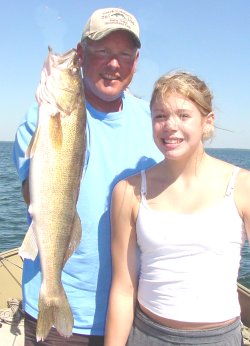 With the bulk of the Mayfly hatches finished and water temperatures moving toward the mid- seventies, my favorite time of the year is heading our way. Mid-summer is the time for mixed bag fishing and when you plan your trip to the right lake, you can catch 3, 4 or more species of fish all in the same trip. This week we’ve enjoyed the Walleye, Perch and Northern Pike mix.
With the bulk of the Mayfly hatches finished and water temperatures moving toward the mid- seventies, my favorite time of the year is heading our way. Mid-summer is the time for mixed bag fishing and when you plan your trip to the right lake, you can catch 3, 4 or more species of fish all in the same trip. This week we’ve enjoyed the Walleye, Perch and Northern Pike mix.
Walleyes have moved in and out of shallow water with the wind this week, but on calm to moderately breezy days they are still generally showing a preference for the deeper water bars and humps. Fish that were feeding heavily on insect larvae are now pumping in the young perch minnows that can be found almost everywhere. Primary choice of baits are live bait rigs with night crawlers or leeches, but on some days we’ve had a little better luck with spinners tipped with leeches. When you want to pick up some bonus Perch and Northern Pike you can add minnows to the mix. Jigs, spinners or live bait rigs tipped with lively minnows will attract more Perch and Pike in the same areas that the Walleye are using.
Perch are particularly vulnerable to the spinner & minnow combo. For Walleyes in the shallows, try using the live bait rig with a lighter ¼ or 1/8 ounce bullet or egg sinker that slips easily in and out of the weeds and fish with crawlers or leeches. When the wind really blows, we’ve had some success with jig & minnow too.
Walleyes on a flyrod? Carl Bergquist, a pioneer of flyrod Walleye fishing proved it can be done. There's still some perfecting to do, but he's hot on the trail.
Northern Pike have been concentrated mostly in deeper water and the two best ways of catching them have been live bait rigging with larger hooks, heavy mono leaders and large minnows like a 6-inch Creek Chub or by trolling deep running crank-baits over open water in the main lake.
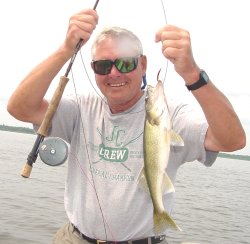 The deep trolling passes should take you near deep structures like bars and humps where the fish are often hanging nearby. As the boat approaches these structures plan your route to run parallel to the structure as often as possible. Deep down Husky Jerks, Number 9 Deep Shad Raps, deep running Reef Runners or Salmo baits are all producing some nice Pike. When you hit the right color you’ll even pick up some bonus Walleyes on the crank-baits as well.
The deep trolling passes should take you near deep structures like bars and humps where the fish are often hanging nearby. As the boat approaches these structures plan your route to run parallel to the structure as often as possible. Deep down Husky Jerks, Number 9 Deep Shad Raps, deep running Reef Runners or Salmo baits are all producing some nice Pike. When you hit the right color you’ll even pick up some bonus Walleyes on the crank-baits as well.
Smallmouth Bass are grouping up on deep-water rock/gravel points and humps. They can still be caught on artificial baits with Tube Jigs and crank-baits leading the way. Live bait rigging with large lively minnows or Leeches will also produce some nice catches, but be careful not to allow the fish too much time to swallow live bait. In general, we release all Smallmouth and live bait fishing can put some of these fish at risk. So try the artificial baits first, then go to the live bait only as needed.
Largemouth Bass are also moving deeper, but can be caught on spinnerbaits or crankbaits fished along the bulrushes and mid depth weed flats. Whether you’re fishing for Smallmouth or Largemouth locating weedlines adjacent to rock stretches or have scattered rock mixed in will tip the odds in your favor.
Bluegills and Crappies have begun showing up in the mid depth weeds and are being caught primarily in the evening using small jigs or plain hooks tipped with a simple cut piece of night crawler. Poke along the weeds slowly and fish until you make contact, then concentrate on that area until you’re convinced there’s a good school of fish. If the action tapers off, move on to a new location. ![]() - Jeff Sundin 218-245-9858 or EMAIL
- Jeff Sundin 218-245-9858 or EMAIL
 Jeff Sundin Fishing Report Archive July 15, 2004 "Mayflies, Baitfish and Sunny Skies! Real Summer Arrives With a Vengeance!"
Jeff Sundin Fishing Report Archive July 15, 2004 "Mayflies, Baitfish and Sunny Skies! Real Summer Arrives With a Vengeance!"
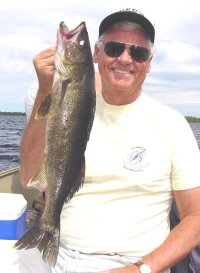 The tables are being turned on anglers who have enjoyed Walleyes that were on an "Auto Pilot" bite for the past couple of months. The Walleyes have found their own "Mother Load" of food and are now feeding on Mayflies, huge schools of young Perch minnows and other assorted mid-summer snack food. The fishing action has tapered off from its peak, but is still fairly good and when you get favorable conditions, great catches are still possible. During the next several weeks it will be common to have one great day followed by a slow day and so on. The fish have so many feeding opportunities that is they who will call the shots about when and where they will be active.
The tables are being turned on anglers who have enjoyed Walleyes that were on an "Auto Pilot" bite for the past couple of months. The Walleyes have found their own "Mother Load" of food and are now feeding on Mayflies, huge schools of young Perch minnows and other assorted mid-summer snack food. The fishing action has tapered off from its peak, but is still fairly good and when you get favorable conditions, great catches are still possible. During the next several weeks it will be common to have one great day followed by a slow day and so on. The fish have so many feeding opportunities that is they who will call the shots about when and where they will be active.
Best fishing approaches have been live bait rigs with a 5 to 7 foot leader using a large, lively Leech. Spinners with bottom bouncers using either minnows or Leeches are also producing some nice fish, we’ve had our best luck with a #2 silver Indiana blade, but red, pink and yellow have produced some fish as well.
Another approach that’s producing some nice Walleye is flat line trolling crankbaits over open water near mid lake bars and humps. We just returned from a trip to Rainy Lake where there were Walleyes were suspended over very deep water and the use of Lead Core Fishing Line helped get the baits down into the strike zone. Watch your graph and determine how deep the suspended fish are, then select your crank baits based on how deep you can fish them. For anglers who put in their time, there will still be plenty of Walleyes to make it interesting.
We've found some of the better Walleye fishing by concentrating on lakes where the bug hatches aren't as heavy. If you aren't limited to one lake right now, try moving around a bit.
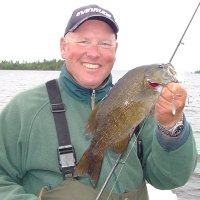 Smallmouth Bass have been scattered and we’ve caught a few on top water baits, spinnerbaits and jigs. They have mainly moved out of shallow spawning areas and are heading for the deeper water points and rock piles. As they go deeper, live bait rigs with large minnows or leeches will catch these fish. Don’t feed line to these fish as you would with a Walleye on a live bait rig. Just hold the line steady while you feel the fish take the bait. Set the hook early to avoid letting the fish swallow the hook. Largemouth Bass are also moving deeper, but can be caught on spinnerbaits or crankbaits fished along the bulrushes and mid depth weed flats. Whether you’re fishing for Smallmouth or Largemouth locating weedlines adjacent to rock stretches or have scattered rock mixed in will tip the odds in your favor.
Smallmouth Bass have been scattered and we’ve caught a few on top water baits, spinnerbaits and jigs. They have mainly moved out of shallow spawning areas and are heading for the deeper water points and rock piles. As they go deeper, live bait rigs with large minnows or leeches will catch these fish. Don’t feed line to these fish as you would with a Walleye on a live bait rig. Just hold the line steady while you feel the fish take the bait. Set the hook early to avoid letting the fish swallow the hook. Largemouth Bass are also moving deeper, but can be caught on spinnerbaits or crankbaits fished along the bulrushes and mid depth weed flats. Whether you’re fishing for Smallmouth or Largemouth locating weedlines adjacent to rock stretches or have scattered rock mixed in will tip the odds in your favor.
Northern Pike have also been susceptible to the deep-water crankbaits. In fact, some of the better Pike we’ve caught in the past couple of weeks have come in on the crankbaits we’ve used during our Walleye fishing. There are certain colors that seem to be preferred by the Pike and we’ve found that by switching colors occasionally, we will eventually stumble into one or two that seem to catch mostly Pike. The colors have changed from day to day, so I’d recommend having a variety of colors to choose from. Deep Diving Reef Runners, Salmo and "Deep-Down" Husky Jerks are all producing some nice fish.
Muskellunge anglers are starting to see and catch some nice fish. The best success has been late evening to dark and fishing main lake weeds with large bucktails.
Bluegills and Crappies have begun showing up in the mid depth weeds and are being caught primarily in the evening using small jigs or plain hooks tipped with a simple cut piece of night crawler. Poke along the weeds slowly and fish until you make contact, then concentrate on that area until you’re convinced there’s a good school of fish. If the action tapers off, move on to a new location.
We've also had some good Crappie fishing in deeper water where we can locate cover in the form of brush piles or "cribs". These fish love to hit baits that are slowly sinking, so these spots are best fished by lowering your jig slowly into or near the brush and enticing the Crappie up to hit your bait. Repeat the process often by lifting up your rod tip above your head and walking the jig back down on a tight line. ![]() - Jeff Sundin 218-245-9858 or EMAIL
- Jeff Sundin 218-245-9858 or EMAIL
Home | Current Fishing Report | Saved Fishing Reports | Favorite Lakes | Fishing Articles Section | Recipes | Rates Services | Gift Certificates | Contact | For Sale | Links | Sitemap |
"The Early Bird Fishing Guide" Jeff Sundin - Fishing Blue Books, LLC 715 Byington Ave, LaPrairie, MN 55744 218-245-9858
Email copyright©2018 Fishing Blue Books, LLC All Rights Reserved - last revised 2-13-18